This is for anyone looking for an Eagle reproduction that’s not only relatively authentic but can also roll up its sleeves and do some heavy lifting.
This set consists of a single Eagle transporter craft and 6 dockable service pods:

Eagle Transporter



The Eagle is the workhorse of the Moonbase Alpha lunar fleet. In fact, it is now the only kind of ship in the Alphan fleet thanks to an unfortunate mishap involving thousands of tons of exploding nuclear waste which propelled them and their moon away from their homeworld and into deep space. The Eagle performs many different roles in their daily struggle for survival and it generally performs very well. It is however a working vehicle not a fighting one and as such combating hostile aliens and what-not is best left to other designs.
The craft is simple and modular in design. The fore section consists of a cockpit/command module attached to a crew/service module. The cockpit is adequately sized for a pilot and co-pilot crew with room for a few spares for unusually risky missions. The fore section is connected to the aft engine section by a dorsal tubular-truss spine. Despite appearances and due to clever design the spine has proven to be impossibly strong and there are no known limits to the amount of weight it can support. The engine section contains all of the technological hooey to support the four nuclear fusion rockets, extended use of which provides the engine room with a nice purplish afterglow. While popular with the kids the Eagle crews prefer to keep as much mass between this section and themselves as possible. Lacking a pod made of solid lead a fully laden passenger transport pod is considered to do just fine.
Handling-wise the Eagle is as quick and nimble as one can expect from a utility vehicle. But while it excels at landing on planetary bodies it has some difficulty lifting off from them. Pilots frequently must resort to what is known as the Carter Maneuver: With all four pads on the ground apply max downward thrust and pull back sharply on the stick. Done correctly you should be propelled into orbit in no time.
Mass: 70.2
Type “A” Passenger Transport Pod


The passenger pod is commonly used to transport Alphans, light cargo and the occasional xenomorph between lunar facilities and for short-term extralunar activities. Features for passenger comfort include:
Type “B” Rescue Pod


When the rescue Eagle appears you can be sure someone is having a bad day. Within its ruggedized exterior it is packed to the brim with all sorts of high tech extrication, intrication, resuscitation and communication gear used to respond to any manner of emergencies in space or on a planetary surface. It features:
Type “C” Laboratory Pod


The transportable laboratory was the brainchild of the Alphan Science Branch. Its main purpose is to. That is to say, it is uniquely qualified for. Well to be honest nobody is quite sure why it exists. But it contains a lot of really neat gizmos and most visitors agree it’s cool how it seems larger from the inside that it does from the outside. It features:
Type “D” Cargo Transport Pod


There was a time when Alphan homeworld politicians concluded it would be safer to launch thousands of tons of nuclear waste through the atmosphere on top of rockets toward the moon to be buried under its surface than it would be to simply shoot it toward their sun or bury it in the middle a big desert somewhere. The cargo transport pod was thus devised to assist with that logistical nightmare. It essentially turns the Eagle into a flatbed truck allowing hazardous cargo to be moved about with a minimum of fuss. It features:
Type “E” Winch Pod



When the Alphan Science Branch finally concluded that burying highly concentrated masses of radioactive material in their back yard was a questionable practice they needed a system to extract the containers from the underground bunkers for relocation. Once again necessity was the mother of invention and the Engineering Branch improvised the winch pod. When not otherwise committed to futile assignments the winch pods can also used to ferry heavy freight. It features:
Mass: 9.9
Type “H” Habitat Pod


Habitat pods are among the oldest of the pod designs. They served as standard living units during the initial phases of Moonbase Alpha construction and were painted orange to ensure visibility in the ever-present haze of stirred up lunar dust. When construction was completed the unneeded habitat pods were eventually auctioned off to private explorers, yacht builders, museum curators and space parade float builders. But a few were preserved and upgraded by the Lunar Authority to be used as mobile office suites by visiting dignitaries and high ranking bureaucrats. The orange coloring was retained in honor of the noble early pioneers. It features:
NOTE: For purists, this is semi-canon. An orange pod carrying the Commissioner of the Earth Space Authority made a cameo in the series premiere and it was later described as “his” transporter. That orange pods were exceptional was thus established. The rest I made up.
Operator’s Manual
All pods share the same docking alignment system and each is equipped with a docking camera. To dock a pod to an Eagle, switch to the docking camera, ensure the ship core is selected, and then maneuver and align the pod to target the docking module at the center of the Eagle’s spine and click. (The Eagle can activate a light adjacent to the docking module to assist when necessary.) When docked correctly you should see half of a green hazard block in the bottom half of the screen.
There are at least two methods to undock. In all cases I have found it best to first reset the docked Eagle’s alignment using the C key. That seems to reduce the chances of pod/Eagle sliding collision during the procedure.
The first method is performed while in the Eagle. Go to Ship->Entity Structure->Fixed Docking System Collective and select “undock all”. Then maneuver the Eagle upwards a few meters until clear. (You can use the downward facing spine camera to assist if you don’t mind being a bit disoriented.)
The second method is from within the pod. Enter the pod’s ship core and switch to the docking camera. The bottom half should display the green hazard block. Ensure the ship core is selected and then click. In normal circumstances you should see no movement but you will be detached. Then thrust *upwards* (not downwards, see below) to clear the Eagle as seen through the camera.
NOTE: Docked pods will actually be attached *upside down* relative to their normal orientation. This seems to be an unavoidable aspect of docking to a docking module from below its normal orientation. [If there’s a way to correct this please let me know.] All of the pods have been designed with this in mind. However this can lead to confusion if forgotten. For example, thrusting a pod “downwards” during the undocking procedure will not have the result you’re expecting and could be disastrous.
NOTE: If you have a lot of undocking collision problems with the habitable pods they are designed to have their docking collars removed with no effect on structural integrity. Just remember to mind the gap when gravity is enabled.
NOTE: When unstacking the Canonical Set it’s best to start from the bottom pod and work towards the Eagle. If you start from the top you’ll likely have collision problems because of the heavier unbalanced mass underneath.
Davetheon
President, Eagle Preservation Society NA
Update:
A note about scale. As small as this model is it is likely still too *big* to accurately represent the genuine Eagle. Here is a vidcap comparison from similar camera angles:


To be fair the vidcap image is somewhat controversial among purists as not being accurately scaled but rather SFX tweaked smaller to fit the requirements of TV production of the day. The intended scale is probably somewhere in between the two scales represented above.
I have not been able to find concrete dimensions for the Eagle from its designers but the consensus from plastic model builders who have done scale conversions is that it is just over 100 feet long, or just over 30m. The game model is 33m stem to stern.
This set consists of a single Eagle transporter craft and 6 dockable service pods:
- Type “A” Passenger Transport Pod
- Type “B” Rescue Pod
- Type “C” Laboratory Pod
- Type “D” Cargo Transport Pod
- Type “E” Winch Pod
- Type “H” Habitat Pod
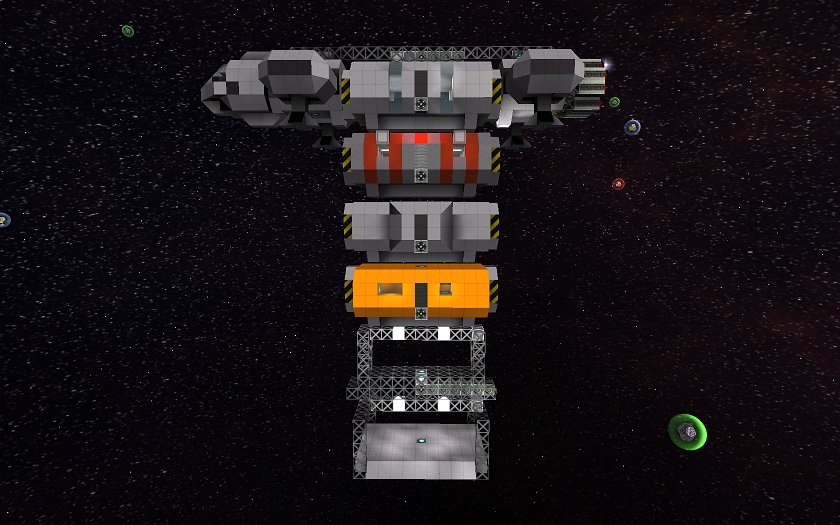
Eagle Transporter
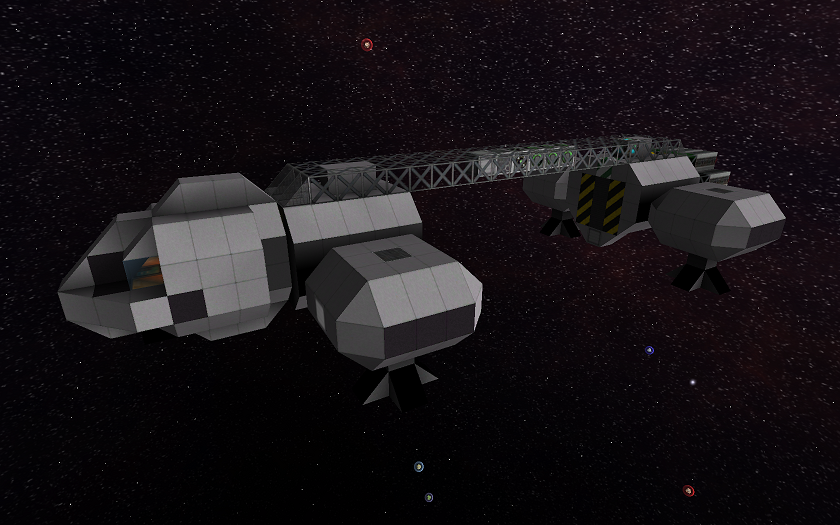
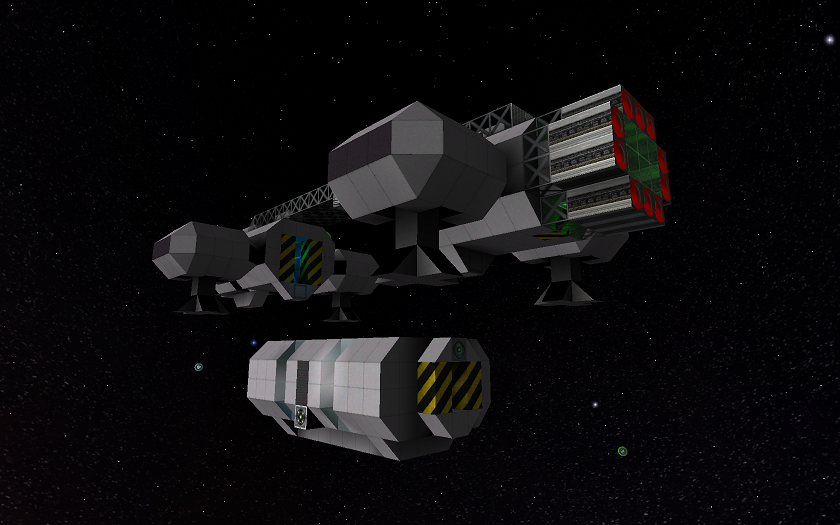
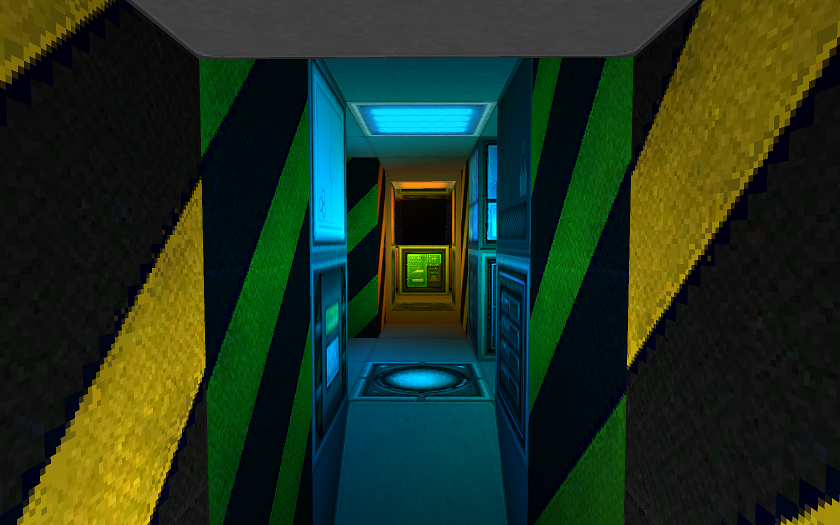
The Eagle is the workhorse of the Moonbase Alpha lunar fleet. In fact, it is now the only kind of ship in the Alphan fleet thanks to an unfortunate mishap involving thousands of tons of exploding nuclear waste which propelled them and their moon away from their homeworld and into deep space. The Eagle performs many different roles in their daily struggle for survival and it generally performs very well. It is however a working vehicle not a fighting one and as such combating hostile aliens and what-not is best left to other designs.
The craft is simple and modular in design. The fore section consists of a cockpit/command module attached to a crew/service module. The cockpit is adequately sized for a pilot and co-pilot crew with room for a few spares for unusually risky missions. The fore section is connected to the aft engine section by a dorsal tubular-truss spine. Despite appearances and due to clever design the spine has proven to be impossibly strong and there are no known limits to the amount of weight it can support. The engine section contains all of the technological hooey to support the four nuclear fusion rockets, extended use of which provides the engine room with a nice purplish afterglow. While popular with the kids the Eagle crews prefer to keep as much mass between this section and themselves as possible. Lacking a pod made of solid lead a fully laden passenger transport pod is considered to do just fine.
Handling-wise the Eagle is as quick and nimble as one can expect from a utility vehicle. But while it excels at landing on planetary bodies it has some difficulty lifting off from them. Pilots frequently must resort to what is known as the Carter Maneuver: With all four pads on the ground apply max downward thrust and pull back sharply on the stick. Done correctly you should be propelled into orbit in no time.
Mass: 70.2
Type “A” Passenger Transport Pod
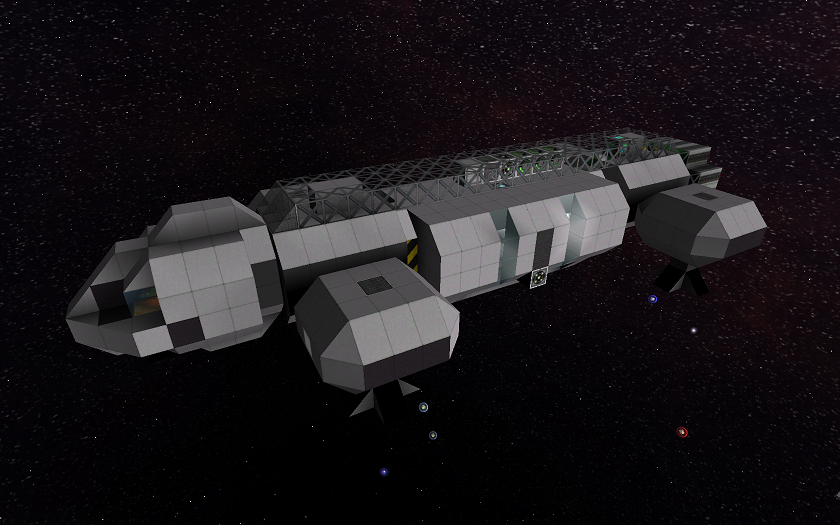

The passenger pod is commonly used to transport Alphans, light cargo and the occasional xenomorph between lunar facilities and for short-term extralunar activities. Features for passenger comfort include:
- Floor to ceiling windows
- Adjustable gravity
- Forward entertainment center with lots of stuff to look at
- Two species-neutral refreshers aft
Type “B” Rescue Pod


When the rescue Eagle appears you can be sure someone is having a bad day. Within its ruggedized exterior it is packed to the brim with all sorts of high tech extrication, intrication, resuscitation and communication gear used to respond to any manner of emergencies in space or on a planetary surface. It features:
- Reinforced structure and sidewalls for maximum survivability in alien environments
- Integrated airlock/decontamination chamber
- Incident command and communication center forward
- Complete infirmary with field surgery capability aft
- Surround lighting with twin high visibility beacons on the roof
Type “C” Laboratory Pod


The transportable laboratory was the brainchild of the Alphan Science Branch. Its main purpose is to. That is to say, it is uniquely qualified for. Well to be honest nobody is quite sure why it exists. But it contains a lot of really neat gizmos and most visitors agree it’s cool how it seems larger from the inside that it does from the outside. It features:
- All kinds of computers and stuff
- Way more floor space than a few scientists really need
- Mysterious twirling blue plasma contained in glass that will probably be a very bad idea at some point
Type “D” Cargo Transport Pod
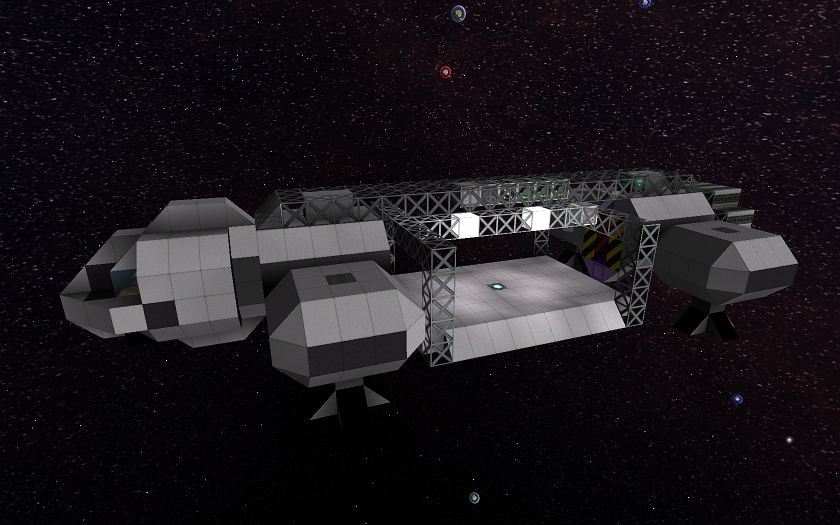

There was a time when Alphan homeworld politicians concluded it would be safer to launch thousands of tons of nuclear waste through the atmosphere on top of rockets toward the moon to be buried under its surface than it would be to simply shoot it toward their sun or bury it in the middle a big desert somewhere. The cargo transport pod was thus devised to assist with that logistical nightmare. It essentially turns the Eagle into a flatbed truck allowing hazardous cargo to be moved about with a minimum of fuss. It features:
- Powerful electromagnetic floor clamps
- Nifty overhead work lights
- Frame made of the same unlimited tensile strength material that the Eagle spine is made of
Type “E” Winch Pod
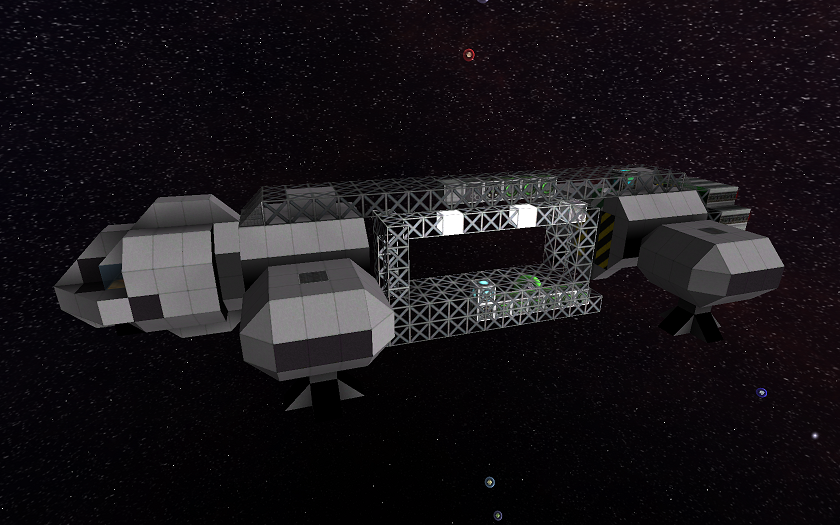
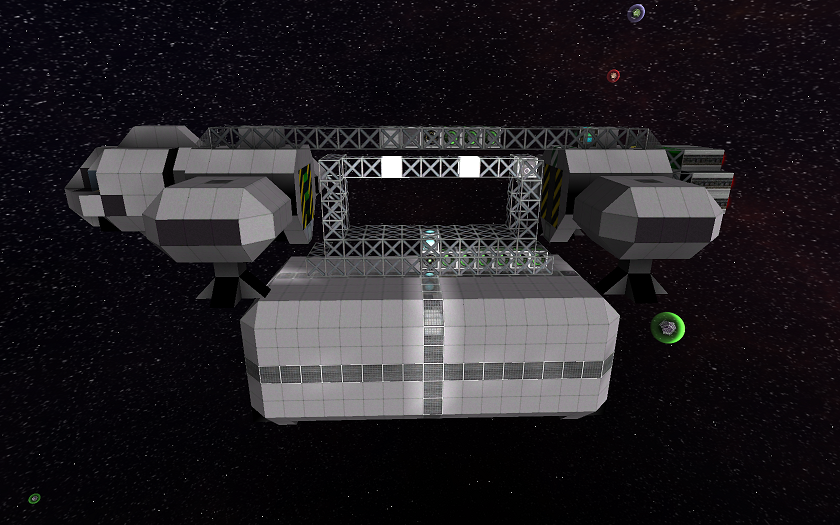

When the Alphan Science Branch finally concluded that burying highly concentrated masses of radioactive material in their back yard was a questionable practice they needed a system to extract the containers from the underground bunkers for relocation. Once again necessity was the mother of invention and the Engineering Branch improvised the winch pod. When not otherwise committed to futile assignments the winch pods can also used to ferry heavy freight. It features:
- Doubles the load attachment capacity of the Eagle
- Novel design makes its intended purpose completely enigmatic
- Fun at parties
Mass: 9.9
Type “H” Habitat Pod


Habitat pods are among the oldest of the pod designs. They served as standard living units during the initial phases of Moonbase Alpha construction and were painted orange to ensure visibility in the ever-present haze of stirred up lunar dust. When construction was completed the unneeded habitat pods were eventually auctioned off to private explorers, yacht builders, museum curators and space parade float builders. But a few were preserved and upgraded by the Lunar Authority to be used as mobile office suites by visiting dignitaries and high ranking bureaucrats. The orange coloring was retained in honor of the noble early pioneers. It features:
- Integrated airlock/sauna
- Remote office suite forward
- Plush comfort suite aft
- Free unlimited movies, games and gourmet coffee
NOTE: For purists, this is semi-canon. An orange pod carrying the Commissioner of the Earth Space Authority made a cameo in the series premiere and it was later described as “his” transporter. That orange pods were exceptional was thus established. The rest I made up.
Operator’s Manual
All pods share the same docking alignment system and each is equipped with a docking camera. To dock a pod to an Eagle, switch to the docking camera, ensure the ship core is selected, and then maneuver and align the pod to target the docking module at the center of the Eagle’s spine and click. (The Eagle can activate a light adjacent to the docking module to assist when necessary.) When docked correctly you should see half of a green hazard block in the bottom half of the screen.
There are at least two methods to undock. In all cases I have found it best to first reset the docked Eagle’s alignment using the C key. That seems to reduce the chances of pod/Eagle sliding collision during the procedure.
The first method is performed while in the Eagle. Go to Ship->Entity Structure->Fixed Docking System Collective and select “undock all”. Then maneuver the Eagle upwards a few meters until clear. (You can use the downward facing spine camera to assist if you don’t mind being a bit disoriented.)
The second method is from within the pod. Enter the pod’s ship core and switch to the docking camera. The bottom half should display the green hazard block. Ensure the ship core is selected and then click. In normal circumstances you should see no movement but you will be detached. Then thrust *upwards* (not downwards, see below) to clear the Eagle as seen through the camera.
NOTE: Docked pods will actually be attached *upside down* relative to their normal orientation. This seems to be an unavoidable aspect of docking to a docking module from below its normal orientation. [If there’s a way to correct this please let me know.] All of the pods have been designed with this in mind. However this can lead to confusion if forgotten. For example, thrusting a pod “downwards” during the undocking procedure will not have the result you’re expecting and could be disastrous.
NOTE: If you have a lot of undocking collision problems with the habitable pods they are designed to have their docking collars removed with no effect on structural integrity. Just remember to mind the gap when gravity is enabled.
NOTE: When unstacking the Canonical Set it’s best to start from the bottom pod and work towards the Eagle. If you start from the top you’ll likely have collision problems because of the heavier unbalanced mass underneath.
Davetheon
President, Eagle Preservation Society NA
Update:
A note about scale. As small as this model is it is likely still too *big* to accurately represent the genuine Eagle. Here is a vidcap comparison from similar camera angles:


To be fair the vidcap image is somewhat controversial among purists as not being accurately scaled but rather SFX tweaked smaller to fit the requirements of TV production of the day. The intended scale is probably somewhere in between the two scales represented above.
I have not been able to find concrete dimensions for the Eagle from its designers but the consensus from plastic model builders who have done scale conversions is that it is just over 100 feet long, or just over 30m. The game model is 33m stem to stern.

Sadly you're right about the scale choking the artistry of the model. I updated the intro page above with scale comparison images if you're interested. I was first and foremost wanting something that was a functional representation of the Eagle concept in game terms and where form conflicted with it function won out. For a much nicer and more accurate artistic rendering check out BinHawkins2013's ERTL Eagle.